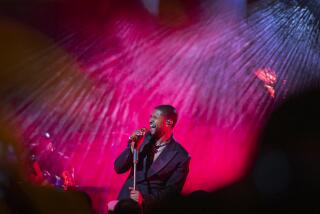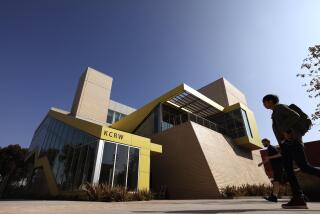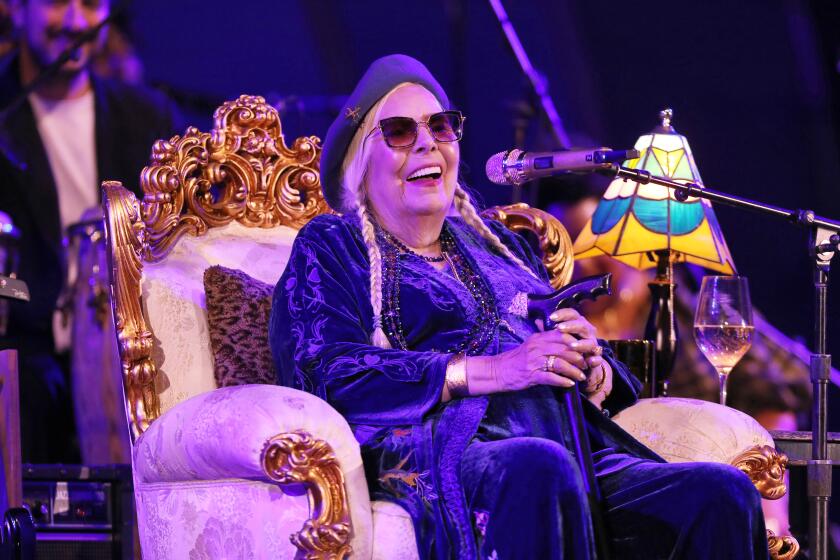KCRW-FM becomes transcontinental
KCRW-FM (89.9) is a well-known advocate for new music, so there’s nothing unusual about the station sponsoring a concert tonight -- except that the performance will be held 3,000 miles from the station’s home base of Santa Monica College.
In a nod to KCRW’s online and bicoastal listeners, as well as a move to raise its profile in the country’s other entertainment capital, the station has lent its name to tonight’s concert by Australian singer-songwriter Butterfly Boucher in New York City.
Nic Harcourt, KCRW’s British-born music director and host of its signature music show, “Morning Becomes Eclectic,” attributes his station’s transcontinental ambitions to the Internet. “I’ve been increasingly aware how our Web listenership has been growing,” Harcourt said, adding that he’s heard from online listeners in San Francisco and New York, “saying they wish they had a station like KCRW.”
“I thought there really was an opportunity to serve the listeners on the Web and to also get more,” he said. The station already has 1,200 subscribers in New York, according to Harcourt. And general manager Ruth Seymour said it hopes to reach even more of the entertainment-industry types who mine KCRW’s playlist to augment their television and movie soundtracks.
Performers whom KCRW touted early in their careers include David Gray, Dido and Coldplay -- and all went on to wider popularity. The station’s status as a musical tastemaker has been outlined recently in the Hollywood Reporter and Esquire. And producers have increasingly tapped KCRW DJs to supervise music for their movies.
Harcourt said starting this series of New York concerts “increases our visibility in the industry and helps cement who we are as a place that is breaking and taking chances on new music. Obviously, it’s important for us to be thought of as a leader in what we do. It’s almost like branding in a certain way.”
He said the station’s imprimatur also can serve as a seal of approval for listeners, who might be unfamiliar with a given musical act: If you’ve heard of KCRW and like the music played there, chances are you’ll like this band, too. Or so the theory goes.
“It’s sort of like a stamp: ‘Pay attention to this artist,’ ” Seymour said. “Especially in an age where radio is so consolidated, there’s less and less diversity in music. Stations like ours have a special responsibility.”
Yes, but why in New York?
Essentially, Harcourt and Seymour insist, why not?
Though the returns are hard to measure, the outlay for the station is almost nil. Its effort consists mainly of Candace Moyer, the KCRW Presents coordinator, contacting New York-area subscribers and offering pairs of tickets for those volunteering to arrive beforehand to affix KCRW posters at the venue, for example.
“We don’t have the resources to make it that big,” Harcourt said, “but we have the opportunity to do some cool things.”
Harcourt pushed to have the station start attaching its name to concerts in Los Angeles after he arrived as music director in 1998, seeing it as a way to get KCRW’s name out in the community and as a means of further exposing bands that the station plays. KCRW Presents grew from about 20 concerts at first to about 250 a year now, he said.
In addition to the New York shows this week, KCRW Presents is attached to tonight’s Orchestra Baobab concert at the House of Blues in West Hollywood and Gemma Hayes at the Troubadour.
Later in the week, the station is sponsoring Lou Reed at the Wiltern Theater in central Los Angeles.
And though it’s difficult to establish direct causation, Harcourt said he’s sure the exposure helps the station -- increases since then in listeners and subscribers, he said, are not just coincidental.
In October, KCRW sponsored a show in New York by Icelandic band Sigur Ros at the CMJ Music Marathon, an annual convention of college-radio programmers hosted by the trade magazine College Music Journal. Harcourt said he heard people in the crowd asking what KCRW was and being informed by others who’d heard it online.
“It just became so clear to me, as I was looking at the audience, that there was a great opportunity to spread the word,” he said.
“Obviously, we’re not going to be doing 200 shows in New York,” he said, but the station will shoot for an average of one a week.
“I think that Nic and the people over there are really on to something,” said CMJ Network founder and chief executive Robert Haber. “I thought it was just a killer idea.”
He said the KCRW sponsorships will be a boon for artists, helping them stand out from the other acts that concert audiences have to choose from. It will also give the bands extra exposure, since New York is, Haber maintained, “unfortunately a very weak market when it comes to radio.”
While there are a lot of good college stations across the country, Haber said, there are none “that really straddle the eclecticism, the marketing savvy and the reach and power that KCRW has. The station really has a national presence to it.”
Online, www.KCRW.com offers a music-only stream, as well as a simulcast of its over-the-air broadcast and a feed of world news from such sources as National Public Radio and the BBC. Listeners can hear any of the three streams on Real and Windows media players, through the Shoutcast broadband service or via America Online.
The station was among the first Webcasters to go online, in August 1995. According to Arbitron ratings, its nationwide audience numbers were consistently Top 20 thereafter.
With its ambitious plans to sponsor concerts regularly in New York, the station leaves itself open to criticism that it is ignoring its local community. It’s a charge Seymour dismisses out of hand.
“We’re local to Southern California, and I think everybody knows that,” she said, stressing that all the programming decisions are made in-house and that 99% of its donations are from the Southland. She also noted that KCRW produces six nationally distributed programs, including Warren Olney’s “To the Point” and “Sounds Eclectic,” the weekly distillation of Harcourt’s weekday “Morning Becomes Eclectic” show.
“The station is basically a local station, but the influence of the station and what it stands for have gone beyond Southern California. And that’s good,” she said. “Everybody understands this is good for the musicians we’re supporting, and that’s the basis of it.”
More to Read
The biggest entertainment stories
Get our big stories about Hollywood, film, television, music, arts, culture and more right in your inbox as soon as they publish.
You may occasionally receive promotional content from the Los Angeles Times.










